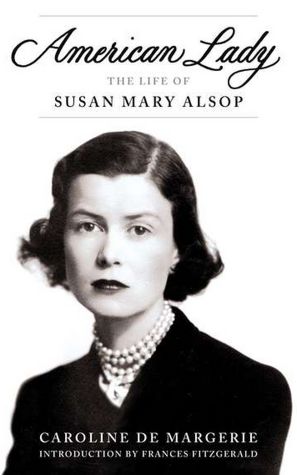Books |
American Lady: The Life of Susan Mary Alsop
Caroline de Margerie
By
Published: Nov 15, 2012
Category:
Biography
Susan Mary Alsop (1918-2004) was a society beauty who morphed into a great saloniste and hostess, but the best reason I found to read this 193-page biography is that it chronicles a low-battery marriage, a torrid romance with a married womanizer and, after the deaths of her husband and lover, a second marriage to a gay man she never slept with.
In short, “American Lady: The Life of Susan Mary Alsop” is a tale of life in the Upper Class before women threw off the shackles.
She knew everyone. She had tea with Edith Wharton. Her frequent dinner partner was Winston Churchill ("He has decided I am . . . French . . . and nothing will deter him from speaking French to me."). The gratin of Paris, Noel Coward, the Duke of Windsor. In Washington, John Kennedy came to her house after the Inaugural parties for a midnight bowl of turtle soup. Lyndon Johnson "pinched her behind and exclaimed, ‘Why does such a thin girl wear a garter belt?’”
She was, in a word, the best — and last — of her breed. And she knew it. "All these stories will be in the history books," she wrote, "but it does send a chill down one’s spine to hear them told by the actors in the drama." [To buy the book from Amazon, click here. For the Kindle edition, click here.]
So come for a peek behind the curtain of International Society. But stay for the sex. And then the cost of sex in Susan Mary’s world: no shame, but great secrecy. And hypocrisy. And the kind of deprivation caused by the absence of flesh on flesh. And, finally, the reckoning.
This is surely not the book that Caroline de Margerie, a family friend, believes she has written. As she tells it, this is the story of a prominent young woman — a descendant of founding father John Jay — who was born in a time of low vocational and high social expectations for upper crust women. Susan Mary married Bill Patten at 20. He had severe asthma, which limited his activity, but he was gentle and kind – he would be “a dear and tender friend.”
When she was 18, her mother offered her either a debutante ball or a trip abroad. She chose the trip. And did it again in her marriage — in 1945, she helped her husband get a government job in Paris, and there her life really began.
The jolt came from her affair with British diplomat and writer Duff Cooper. He was married to Lady Diana Manners, a high-spirited beauty who knew exactly the kind of man her husband was: a compulsive womanizer. This was not, for her, a problem. “She asked only to be kept informed.”
Susan Mary’s husband had no such tolerance, so he was never informed. Or maybe he knew but pretended not to — in those days, many couples had secret, separate lives. And women like Susan Mary were, in their way, great actresses. “She walked into adultery as tremulously as a governess into her first job; yet she turned out to be a natural, maneuvering like a seasoned courtesan.”
Very seasoned. When she learned she was pregnant, Duff Cooper could not have been less interested. The boy was named William Samuel Patten, Jr. He looked a lot like Duff. Bill never knew. Or pretended not to.
Patten died. His close friend Joe Alsop came courting. The world didn’t know he was gay — he was an important Washington journalist, and the revelation would have ended his career — but he didn’t lie to Susan Mary. Why marry him? She needed a father for her children. And she and Joe would make a great team.
The Alsops took Washington by storm. Just one problem: In private, Joe could be a total shit to his wife. And was. Often. This time she didn’t take a lover. She just endured. Wrote. Entertained. And found comfort in alcohol.
The last years of any life can be problematic. Susan Mary was too well-bred to surrender to bitterness — in company, she never dropped her game face. But in a stint in a rehab center, at a family meeting, she drops a bomb that shocked me. And will make you rethink much of what you’ve read.
“American Lady: The Life of Susan Mary Alsop” is a cautionary tale.


